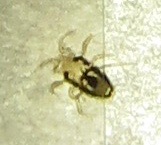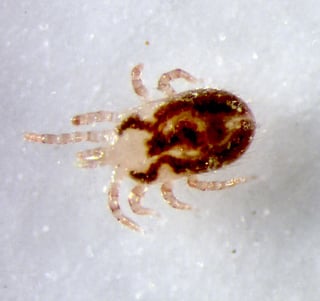I saw a decimal-sized dot walking on my hand. I wanted to know what this is, so I got it onto some paper and sandwiched below a piece of clear tape so I could keep it in place and photograph it. However it's so small that even with my camera lens almost touching the specimen, I can't get a great photo. It's small, about 0.8mm long, beige or gray or brown with a pattern on the back. It's a little smooshed from the tape so it's hard to tell if it has 6 or 8 legs and is an insect or an arachnid. But hopefully based on the shape, size, and pattern it can be identified.
Location is southern California.
Update: I now believe this to be a rat mite or bird mite. I'll include some additional photos that were better quality (photos were taken with a close-focus camera, mites were on printer paper underneath Scotch tape, back-lit by an LED light):









